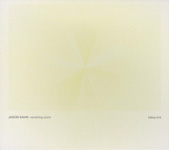|
|
 |
Dusted Reviews
Artist: Jason Kahn Album: Vanishing Point Label: 23five, Inc. Review date: Aug. 5, 2009 |

|
|
|
 |
Art imitates life, and, in some cases, life imitates art. Or at least this is the assumption – that the two, art and life, are somehow separate, that one causes the other. But what about when the two are actually intertwined, inseparable from each other? This argument gets convincing support in Jason Kahn’s latest solo full-length, which is cast in the brief liner note as a tribute to his late daughter, Louise. “While I was working on this piece,” he writes, “I was thinking of my daughter Louise, who died two years ago. I guess the title refers to her vanishing, though I can’t say exactly. I just know I was thinking of her a lot when I was working on this and then this title came to mind.” So the title, at least, came from life. But what of the work itself? That’s not so clear-cut; “I can’t say exactly,” he says.
“Vanishing Point” is a single, 46-minute composition built from agitated metals (presumably cymbals), muted static, field recordings and some low-frequency vibration. For the first third of the piece, the static (accompanied by some undulating strains of delicate feedback) is the dominant sound. The mix is crowded and blurred, almost claustrophobic. But around the 15-minute mark, a shift occurs, so subtle you miss it at first. Underneath the wash of almost white noise, a mass of activity appears – the constant, brassy rattle of a cymbal, a spectral melody humming in the bass. An idea emerges, dissipates, something new appears. This progression continues for the remainder of the piece, which slow-fades to an elegiac hum of gently resonating metals and flickers of static at its conclusion.
The piece, then, does just what the title says: it gradually vanishes. But this inverted shape and change of activity has the effect of revealing more and more detail, as only when Kahn removes an element do you notice its full impact. Only after the hissing static disappears, for example, do you realize how truly dominant it was, likewise the subdued melody in the bass range. But it’s not a simple case of subtraction or a decrease in volume at work, but rather a shift in dynamic relationships – background becomes foreground, what was incidental takes the focus. What was there gets replaced by something else. It’s inevitable.
Significantly, Vanishing Point represents a similar kind of shift in how we hear Kahn’s whole body of work. Much of it has tended to come off as austere radio research (such as graphical scores and location-specific installations), investigating vibration, space, dynamics and how musicians interact with these. Our assumption of art following life would play out here: Kahn is interested in these phenomena, therefore he makes art that investigates them. But if we consider that separating art from life is not so easy, then his work, and Vanishing Point in particular, start to become something much more nuanced, much more personal. As listeners we get to hear how Kahn is hearing. We get a new pair of ears, a new way of perceiving. No longer objective and fixed, but subjective and fluid. Less science, more poetry.
By Matthew Wuethrich
|







